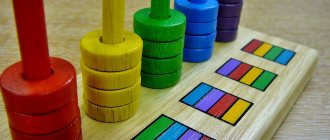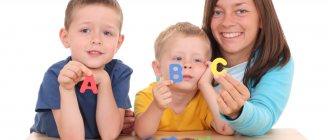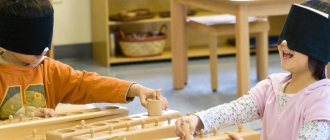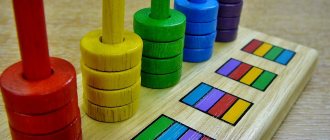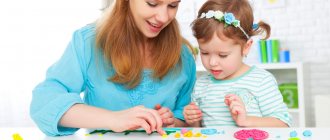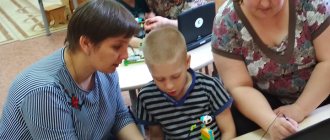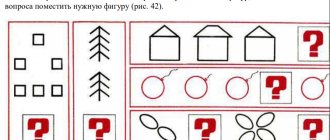What is logical thinking
Logic is a science that studies the methods and forms of thinking. At the same time, logical thinking is a special type of thinking that uses certain logical rules, structures and concepts.
In children, logical thinking is developed as a result of imaginative thinking. Such thinking is the highest point in the purity and logic of a child’s thoughts. The path to this point is not easy and long, which requires high mental activity and enormous knowledge.
The development of logical thinking in a child is a rather complex process that covers many different cognitive functions and includes various activities. This is the ability to explain complex things to a child in a simple language that he understands, teach him to establish relationships, teach him to evaluate a situation and draw conclusions from it. But not all parents know how to do this correctly.
When we were growing up, no one read smart books on psychology and child development. Our parents simply talked to us like adults, explaining everything that was happening around us. We counted cars of the same color, the same make, observed insects, birds, animals, and absolutely everything was commented on by our parents.
Nowadays, parents strive to earn more money and climb up the career ladder; children are left to their own devices or disappear behind computers and tablets, “conquering” the frontiers of online games. All the logic of children comes down to being able to turn on the gadget.
Ways to develop logical thinking in preschoolers
Elena Donskova
Ways to develop logical thinking in preschoolers
Children, when they come to school, read well, count well, have a fairly wide range of ideas about the world around them, but often cannot concentrate and master new material, and carry out assignments carelessly. Why? Because successful preparation for school requires not only knowledge, but also the development of mental processes, in particular thinking . The child needs to be taught to think in games, especially in logical ones . They develop the ability to understand an educational and practical task, choose ways and means of solving it, control themselves, and properly manage their behavior.
Logical thinking is thinking through reasoning. Reasoning means connecting various knowledge with each other in order to ultimately obtain an answer to the question facing him.
All types of logical thinking : - visual - effective; visually - figuratively; logical is inextricably linked with speech. Speech is the only form in which thinking . When reasoning silently to ourselves, we use abbreviated internal speech. In the process of thinking, such actions as comparison, analysis, synthesis, systematization, classification, generalization, seriation develop .
In an integrated approach to the education and training of preschoolers, an important role is given to entertaining educational games , tasks, and entertainment . They are interesting for children and emotionally captivate them. Through games and exercises, children master the ability to search for solutions independently. Entertaining tasks help develop the child’s ability to quickly perceive cognitive problems and find the right solutions for them. Children begin to understand that in order to solve a problem correctly, they need to concentrate and understand that such a task contains a “catch”
and realize what the trick is. For example: If a goose stands on two legs, then it weighs 4 kg. How much will a goose weigh if it stands on one leg? /4 kg. /
Riddles are wonderful examples of oral folk art. Riddles of mathematical content contribute to the development of thinking , the ability to prove the correctness of judgments. Each riddle is also a logical problem , in solving which the child must perform complex mental operations. It is important to teach a child not only to guess riddles, but also to prove the correctness of the answer.
For example: Three tips, three corners,
Three sides - here I am. /Triangle /
The child is asked questions: “What is this riddle about. Why do you think so. Which triangle could be the answer. The child comes to the conclusion: “Any triangle can be the answer.”
For example: There are four legs and one cap.
Needed when the family starts having dinner. /Table/
During the discussion, children are asked a provocative question: “Or maybe it’s about a chair.”
.
Thus, we develop the ability to prove the correctness of the guess.
The most effective aid for the development of logical thinking is Dienesh's logical blocks . A set of logical blocks makes it possible to identify and abstract one property in objects (color, shape, size, thickness, compare, generalize objects (by color and shape, shape and size, size and thickness)
. Depending on the age, you can use not the entire set, but some part of it: first, blocks are different in shape and color, but the same in size and thickness, then different in shape, color and size, but the same in thickness, and then the whole set figures.
Puzzle games occupy a special place in educational The essence of the game is to recreate the silhouettes of objects on a plane according to a model or design.
Puzzle games: “Tangram”
,
“Magic Circle”
,
“Pythagorean Puzzle”
,
“Columbus Egg”
,
“Vietnamese Game”
, etc., all these games are united by a common goal,
methods of action and result.
Children are attracted to games by their entertainment, freedom of action, and the opportunity to show creativity and imagination. Each game is a set of geometric shapes. It is obtained by dividing one geometric figure into several parts. All games are effective: a planar, silhouette image of the object is obtained. Each game has its own set of elements and has only its own capabilities. So from the details of “Tangram”
you can lay out silhouettes of animals, people, letters, numbers, from
“Columbus Egg”
- silhouettes of birds, and
“Leaf”
makes it possible to create silhouettes of various types of transport.
Puzzle games contribute to the development of analytical-synthesizing and planning activities in children, improvement of sensory skills, development of creative thinking , moral and volitional qualities of the individual.
Developmental games used in working with children Nikitina P. “Cubes for everyone”
,
“Fold the Pattern”
, Voskobovich’s games
“Magic Square”
,
“Ice Pieces”
,
“Transparent Numbers”
, etc.,
contribute to the development of logical thinking , memory, imagination, creativity.
The game plot, which includes tasks and exercises, allows you to find a search motive that is meaningful for children. This could be rescuing a hero or casting a spell on a princess, etc. Children of older preschool age are interested in logical games involving movement and rearrangement. These games have some features: the presence of a playing field, game actions, chips and the final result - winning or losing. These include : "Counter move"
,
“Changing positions”
,
“Checkers”
,
“Chess”
,
“
Logical chains ” , etc.
An indispensable condition for the development of logical thinking in children is the active position of an adult, systematic teaching, availability of game material, taking into account age characteristics, guiding children's activities, stimulating activity, initiatives, praise, encouragement.
Thus, children with well- developed logical thinking easily “fit in”
into the school team, they know how to think originally, are self-confident, active and cheerful.
Speech games for developing logic
These games will be useful for developing correct speech in a child, increasing vocabulary, and the ability to accurately select definitions.
A linguistic logic problem is a short story with some kind of riddle in it. And instead of an answer, a few questions addressed to the child. He can answer them if he understands certain laws of nature and can build logical connections. In the process of solving a problem, different thinking techniques are used: identifying various properties, comparison, analysis, generalization. The child also needs to independently formulate a clear answer.
An example of a linguistic task for the development of logic
“One day in the forest, after a night when it was pouring with all its might, a beautiful sunny morning came. Winnie the Pooh and Piglet ran out into the yard and immediately saw two huge puddles. One larger one is for Vinny, the second smaller one is for Piglet. Friends happily started jumping in puddles! Soon Tigger joined them. Together they decided to invite the Rabbit as well. Everyone ran to him, but the Rabbit, as you know, was a very busy person, so his friends had to persuade him for a very long time. When the Rabbit finally agreed, and everyone returned to the Rain Glade, they discovered that Winnie the Pooh’s puddle had become very, very small, and Heel’s puddle had completely disappeared! - How so? – Piglet was surprised. “There was a sea here recently, but now not a bit of it remains.” Where did the puddle go?”
After the teacher’s answer or explanation, you can invite the children to conduct several experiments. For them you will need two brushes and two glasses of water. One with plain, the second with added salt. Use brushes dipped in different glasses to paint paths on dry asphalt. The liquid will evaporate, but the salt will remain. You can draw such stripes in the sun and in the shade. Let the children themselves try to explain what is happening and how.
This also includes games where children are asked to describe what is drawn in the picture, compose a story based on the pictures, continue a fairy tale they heard, and more. Closer to four, you can suggest a game of “turning words”. In this game you need to change one letter at a time in a word until, as a result of a chain of transformations, you get the desired word. Examples of such chains: house–som–sok; whale-cat-mouth; edge-cut-mole.
Game "Continue the word." Children stand in a circle and throw a ball to each other. The one who throws says the beginning of the word, and the one who catches ends it. You can play by naming synonyms and antonyms of words.
Graphic games
These games are worth highlighting in a separate category. Their purpose is to engage hand-eye coordination. Usually such games are collected in notebooks and collections, and there are children's periodicals. These are different labyrinths, logical tables, where you need to answer a question, complete something, draw something, mark it. This category includes games with geometric shapes, puzzles, and crosswords. The simplest graphic game for developing logic is “tic-tac-toe”. A child can handle a three by three sign as early as 3.5-4 years old.
We suggest you work with your child using a very good book “Logic for 3-4 years. Test tasks":
Computer games for developing logic
In most cases, these are logic games for which cards with pictures are used, only in the format of a computer game. The child is attracted by the bright animation, familiar cartoon characters, and the interactivity of the game. For him, this is also the construction of a new model of the “man-machine” relationship, where he acts as a manager. The process of mastering the mouse develops hand-eye coordination.
There are many computer logic games that you can play online. On gaming sites they are usually divided by the age of the child. There are many examples of such games, including associations, mosaics, Sudoku, games “Extra object”, “Cold-hot”, “Artist’s mistakes”, “Connect the dots” and others.
Larger computer games containing several progressively more difficult levels may require installation on your computer. The Russian one has released a whole educational collection “Smart Games”, among which there is a part “Development of Logic and Imagination”.
When a child works at a computer, it is very important to follow the following rules:
1. Strictly limit the time spent at the computer. For a child 3-4 years old, a 10-15 minute lesson will be enough. 2. Monitor the correct position at the computer, monitor posture and breathing. 3. After class, do a little physical and eye warm-up.
What is thinking
Every day we make many decisions: how to get from point A to point B faster, what to give a friend for his birthday, how to solve a difficult problem at school or in everyday life.
And although the world is full of uncertainties, the way we reason still partially influences the outcome. Thinking is when we learn something: we systematize and analyze information, build connections, highlight what is important, discard what is unnecessary and draw conclusions.
How it works
Thinking “does” the brain, and the result is called thought.
To understand how to develop thinking, it is important to clarify: thinking itself can be different - it all depends on what kind of work our brain does.
| Visually effective - this is when we make a decision right within a situation that is constantly changing. Chess and puzzles are a great example. A very useful skill for a world that changes every day - and what’s more, sometimes several times a day. Visual-figurative means imagining some situation or image, but not actually doing anything with it with your hands. For example, to see something familiar in a random passer-by and think about what it is connected with: maybe he looks like a neighbor or a famous actor (or is he the same actor)? Verbal-logical - we use this type of thinking when we group objects by characteristics (smartphone, fitness bracelet, wireless speaker - gadgets), affirm or deny something (the weather is good outside, the sun is shining and it’s warm / the weather is terrible outside, the sun is shining and it is very hot) or we draw conclusions based on judgments (mom said that she is busy with work in the evening - that means she will not come to the parent-teacher meeting). Theoretical thinking is a favorite pastime of scientists! When they conduct experiments, they isolate and analyze different characteristics of phenomena. All this helps to mentally change the object and study it in detail. For example, you need to decide what is better to take for a snack at school: a banana or an apple. Let's analyze: a banana is soft and can ruin notebooks in a backpack, an apple is hard and takes up less space. The choice is obvious! Practical thinking is to set a goal to learn English and come up with a plan for this task so that there is motivation to continue. Creative thinking is when we solve simple problems out of the box: we use imagination, systematize and analyze. For example, you need to figure out how not to worry at a family photo shoot. You can invite parents to portray different animals and communicate with each other in their languages. Then the shots will come out with smiles, and the process will be fun. |
Methodology “DIVIDE INTO GROUPS”
The child is shown a picture and given the following task: “Look carefully at the picture and divide the figures presented on it into as many groups as possible. Each such group should include figures distinguished by one characteristic common to them.
Name all the figures included in each of the selected groups, and the characteristic by which they are selected.” You have 3 minutes to complete the entire task.
Children's performance of the proposed tasks was assessed using a ten-point system, where:
8-10 - high level
5-7 - average level
0-4 - low level
Khlyupin Yu.A., Osotov V.N. Methods for diagnosing high-voltage oil-filled power electrical equipment (Document) Kostyukov V.N., Naumenko A.P. Automated quality control and diagnostic systems (Document) Educational game logic tables (Document) Presentation - Psychophysiology of attention (Abstract) Grudyanov A.I., Zorina O.A. Methods for diagnosing inflammatory periodontal diseases A guide for doctors (Document) Velichkovsky B.M. Modern cognitive psychology (Document) Klyuev V.V. Non-destructive testing and diagnostics. Directory (Document)
Games and tasks
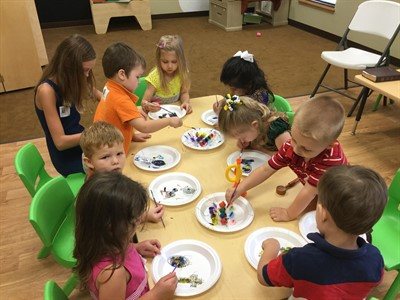
This is a complex, lengthy process that cannot be left to chance.
It is necessary to start working on the development of logic in early childhood.
For 4-5 years
At this age, the baby can:
- find similarities and differences between objects;
- design according to a model;
- connect a picture cut into pieces (no more than 5 parts);
- hold a learning task for several minutes;
- call a group of objects with a common word;
- determine a pair for an item;
- find errors in illustrations, explain;
- choose simple words - antonyms.
The following games are used for this age:
- Didactic. This includes all board games on a printed basis with tasks: find the extra object, name it in one word, show 10 differences, color only the animals, etc.
- Developmental. Games are built on the principle of increasing complexity. As soon as the child copes with the initial stage, the tasks become more complicated.
- Speech. Using fantasy and imagination, the child completes tasks to develop logic: continue the story, help the heroes of the fairy tale make the right decision, start the fairy tale so that the illustration becomes a continuation, etc.
- Graphic. They are especially popular with children; the children act as co-authors of tasks: guess and complete the drawing of an object, go through a maze together with a famous hero, bring a picture to life using a colored pencil, etc.
For 5-7 years
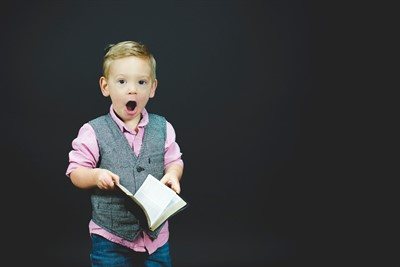
During this age period, there is an awareness of the basic properties of the features of an object, and the ability to subsequently apply knowledge in practice.
Knowledge of the surrounding world occurs through verbal stories.
The external activity of the child is increasingly being replaced by the activity of internal mental operations.
Try inviting your child to play a game; it will not only be fun, but also useful.
- Game "Wizards". The child is asked to use a simple figure (for example, a rectangle) to create a more complex one (a house, an aquarium, a truck).
- Game "Logical endings". The preschooler is asked to complete sentences of different content. For example, if Masha is taller than Petya, then... (Petya is shorter than Masha).
- Game "Ornament". Geometric shapes of different colors and sizes are assembled into a pattern. The child needs to assemble the same one according to the model, come up with his own, using spatial concepts.
- Game "Helpful - Harmful." During the game, consider objects or phenomena familiar to the child and give the opportunity to name positive and negative aspects, based on your life experience.
- Game “What am I up to?” One of the players makes a wish for an object, the second asks questions, trying to guess what was wished for. The questions are answered in monosyllables: YES or NO.
Methodology "NONSANE"
Goal: to determine the level of formation of analysis as an operation of logical thinking. Using the same technique, the child’s ability to reason logically and express his thoughts grammatically correctly is determined.
Carrying out the technique:
First, the child is shown a picture. There are several ridiculous situations in it. While looking at the picture, the child receives instructions approximately as follows: “Look carefully at this picture and tell me if everything is in its place and drawn correctly.”
If anything seems wrong, out of place or incorrectly drawn. Then point it out and explain why this one is wrong. Next you will have to say how it really should be.”
Note. Both parts of the instruction are executed sequentially. First, the child simply names all the absurdities and points them out in the picture, and then explains how it really should be.
The time for exposing the picture and completing the task is limited to three minutes. During this time, the child should notice as many absurd situations as possible and explain what is wrong, why it is not so and how it really should be.
Diagnostics of the thinking of preschool children
In preschool age (3-6 years), children absorb knowledge about the world around them like a sponge. The larger their areolas of cognition, the more characteristics of surrounding objects they know and the more synonyms they can present.
Types of thinking characteristic of preschoolers:
- visually effective (up to 3 years) – is expressed in the fact that recognition of the properties of an object occurs through physical contact with it;
- visual-figurative (from 3 to 5 years) - during this period the child is already able to operate with images of objects without having them at hand, to replace some objects with others in the game;
- verbal-logical (5–6 years old) – children learn to operate with abstract concepts, without the use of visual aids, relying on reasoning and evidence.
In preschool age, of the three types of thinking described, the first two are the most developed; verbal-logical thinking is just beginning to develop. That is why in tasks for preschoolers images of objects should be used, and not their verbal designations.
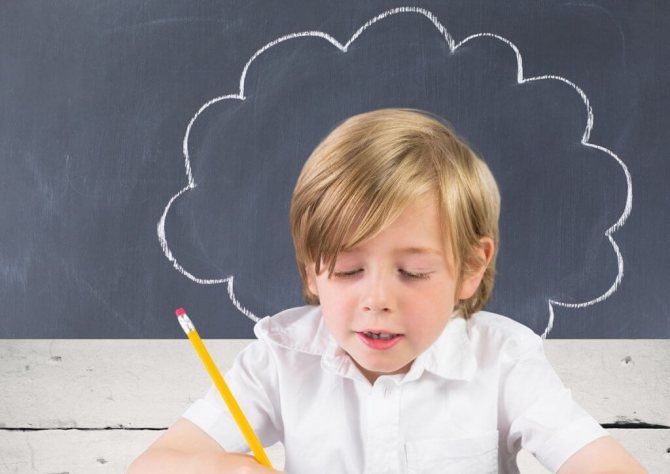
Source: Psychological and pedagogical diagnostics: Textbook. aid for students higher ped. textbook institutions / I.Yu.Levchenko, S.D.Zabramnaya, T.A.Dobrovolskaya and others; Ed. I.Yu.Levchenko, S.D.Zabramnoy. - M.: Publishing House, 2003. - 320 p.
In psychology, thinking is understood as the process of an individual’s cognitive activity, characterized by a generalized and indirect reflection of reality. Objects and phenomena of reality have properties and relationships that can be cognized directly, with the help of sensations and perceptions (colors, sounds, shapes, placement and movement of bodies in visible space).
Methodology for diagnosing thinking “Pyramid addition”
Purpose: folding a pyramid is used to identify the state of visual-effective thinking.
Equipment: to conduct the experiment, you must have several pyramids consisting of 4, 6, 8 rings and a cap.
Progress of the study: the child is shown a pyramid (the number of rings depends on age) and is asked to disassemble it, accompanying the instructions with the appropriate gesture. If the child does not start working, the experimenter himself disassembles the pyramid and asks the child to assemble it. If a child, having started to act, collects the pyramid in disarray, he is not stopped until the end of the work, then they say “Wrong” and the work begins again. The experimenter draws the child's attention to the largest ring and invites him to put this ring on the rod. If the child does not continue the work himself, the experimenter does it by putting on the next, smaller ring and continues this way until the entire pyramid is folded.
Then the experimenter once again invites the child to disassemble and fold the pyramid himself, without interfering with the progress of the work.
The protocol notes the composition of the pyramid, the experimenter’s explanations and actions, the child’s actions, and his verbal statements; Does the child immediately accept the task, his first actions, when he begins to fold the pyramid, taking into account the sizes of the rings. The child’s way of working is noted (puts on rings not in accordance with their size, does not correct the mistake himself; compares rings by size, not yet putting them on the rod, applying them to each other; visually correlates them, putting on all the rings correctly at once).
Based on the analysis of the protocol, a conclusion is made whether the child is learning the method of action. A child with intact intelligence, as a rule, performs this task correctly right away. Chaotic manipulations with rings, performing a task by trial and error while repeatedly folding the pyramid on your own most often indicate a decrease in intelligence.
Diagnostic technique “Folding cut pictures».
Purpose: the technique is used to identify the state of visual-figurative thinking. This technique does not require the participation of the child’s speech, so it can be used for examination of speechless children.
Equipment: to conduct the experiment, it is necessary to have cut-out pictures of varying complexity: from the simplest, divided into two parts, to those consisting of 4 - 5 - 6 parts of various configurations (the complexity of the proposed pictures is determined by the age of the subject).
Most of the pictures are on a rectangular background, this makes it easier to draw up a picture by outlining its boundaries. The task is complicated not only by the number of parts and the configuration of the cut, but also by the display of pictures on both sides of the rectangle. The reference point for such cut-out pictures is primarily the background color. A one-sided cut-out picture may be offered, which shows only the outline of the object (car, bear, doll, etc.). An even more complex option is a drawing separated from the background, i.e. cut along the contour and cut into 4 - 5 parts.
Progress of the examination: first, the child is asked to put together a picture of three parts on a rectangular background. The parts of the picture are placed in disarray on the table in front of the child and, without naming the object depicted in the picture, they are asked: “Fold the whole picture.” If the child does not know where to start, the experimenter himself puts together one main part and encourages the child to continue working. If the child again acts incorrectly, randomly, the experimenter folds the picture himself, draws the subject’s attention to it, again mixes the parts of the picture and suggests: “Now fold it yourself.”
After preliminary completion of the task (independently or with the help of an experimenter), the child is given a cut picture of 4-5 parts and the instruction: “Fold it yourself.” The experimenter does not interfere with the progress of the work. But first he gives instructions: “A rooster is drawn here. Lay down a whole rooster.”
The protocol notes the name and composition of the picture, the experimenter’s explanations, the child’s actions and his verbal statements.
The researcher obtains the main facts by analyzing the method of action that the child uses in the process of putting together a picture. These can be chaotic manipulations that have no purpose, purposeful actions in a visual-effective plan (trial and error method) and purposeful execution of a task in a visual-figurative plan (visual correlation).
An inadequate method of action is expressed in the fact that the child works chaotically, placing parts of the drawing without a specific goal. For example, he puts his tail on the animal’s head, sometimes it gets “stuck” on the layout he has made, and places all the other parts of the drawing as needed. If a child stubbornly does not accept the experimenter’s help and even after repeated visual demonstrations cannot put the picture together correctly, this cannot but raise doubts about his intellectual development.
Diagnostic technique "Seguin Board".
Purpose: this technique can be used to study visual-effective thinking.
Equipment : boards with grooves of various geometric shapes and corresponding tabs are used (there are variants of these boards of varying complexity). An elementary board of four tabs is available for presentation to children from the age of two. The most common version of the Seguin board (of 10 tabs) is presented to children over three years of age. The difficulty is that some grooves can only be filled with a combination of several tabs.
Methodology for conducting the experiment: the experimenter shows the child a board with laid tabs, then pours them out and with gestures suggests returning them to their place.
Difficulties in completing tasks indicate deficiencies in visual perception and an insufficient level of development of visual-effective thinking.
Methodology “Plot Tabs”
In structure, this technique is close to the Seguin Board technique. During the experiment, a large board is used, which depicts 10 different situations with missing elements in place of the cut grooves, and tabs with drawings depicting these or intentionally incorrect elements. The child must choose from a large number of tabs the appropriate one in meaning.
When assessing the results of this task, attention is paid to how the child comprehends the situations depicted on the board, how focused and stable his attention is. Observing the child's way of working is of considerable interest. The first method: the child, picking up any tab, looks for a place for it. This method is irrational and unproductive. The second, more advanced method: the child, having comprehended the situation, searches among the tabs for exactly the element that is needed. Intellectually mature children (5-6 years old) are able to correctly understand the situation and choose the appropriate tab. It should be noted that they cannot always independently use a more rational way of working. However, with direction from the experimenter, they learn this method.
The technique also makes it possible to identify the purposefulness of activities with a large amount of work. Children whose attention span is insufficient, even with a good ability to comprehend, often find it difficult to complete this task, since they are not able to cover all the situations depicted and make a choice from a large number of tabs. If limiting the amount of work (some situations are closed and the number of presented tabs is reduced) leads to an improvement in its quality, then we can conclude that the cause of the errors was not difficulties in comprehension, but a narrowing of the scope of perception.
Diagnostic method “Mailbox”
Purpose: examination of children of different ages, study of visual and effective thinking, allows us to identify the child’s ability to comprehend a new method of action.
Equipment : The “mailbox” is a box with a removable lid. The lid has slots of various configurations. Multi-colored figures (each in two copies) with their bases repeat the shape of the slot on the lid of the box.
This technique does not require verbal responses from the child during implementation, therefore it is very convenient in working with speechless children. Instructions, depending on the age of the subject, can be given in several versions: verbal (“Here are different figures. Place all the figures in this box”) or visual (the experimenter shows the execution using two or three figures).
For a child of normal intelligence 6 years and older, this task is not difficult and is performed by visually matching the shape of the base of the figure with the shape of the slot. In some cases, children resort to trying on (usually in relation to two figures: a triangle and a semicircle, which require a certain turn). The choice of figures by such children is usually made in a certain system: for example, having dropped a square into the “box”, the child then takes an identical figure. Children with intellectual disabilities at 7-8 years of age rarely act by visual correlation; the path of trial and error is more typical for them.
| Download a ready-made calculation using this method | Order a ready-made calculation using this method | Ask us a question about this method |
At the moment we do not have a ready-made calculation for this method, perhaps it will appear later. If you want to order an exclusive calculation using this method with your conditions or in combination with other methods, write to us by clicking on the second link. If you think that the methodology contains unreliable data or you have questions about conducting research on it, click on the third link.
How to develop logic and thinking in children 5, 6 and 7 years old
At the age of 5-7 years, children spend most of their time in kindergarten. Therefore, all classes are conducted by a teacher in the classroom.
Children of primary preschool age can develop thinking in the following ways:
- conducting conversations and discussions. Children of this age can not only perceive information, but also express their opinions and make simple conclusions;
- conducting didactic games and performing exercises with logical content, solving puzzles. Assignments may be in printed form;
- games that involve both creativity and logic. A child will remember best what he created with his own hands. Therefore, he can be asked to complete the following tasks: complete the missing part of a geometric figure, give the missing items: a fishing rod to a fisherman, a car to wheels, etc. It is necessary that the child can explain his choice;
- using the “intentional error” technique. At the age of five, a child has already formed ideas about humor and their thinking is sufficiently developed not to take on faith everything that adults say. It is possible to use an intentional error in any class, the main thing is that the material is familiar to the children;
- use of substitute items. This technique, by transferring some properties of an object to a replacement one, develops thinking, imagination, and creative abilities. Children are able to imagine imaginary properties of objects;
- use of signs and pictograms. In the fifth year of life, the baby becomes familiar with numbers. By studying them, the child develops abstract thinking. Using numbers, the child should be able to collect identical objects into a group and indicate their number. First, simple tasks are offered: objects are arranged in a row. The child must determine their number by pointing to a certain number. Then the task becomes more complicated: objects of two types are laid out randomly (for example, 3 apples and 2 pears). The child must be able to determine the quantity of each item and point to the corresponding number;
- pictograms are images of objects in a simpler form. They convey the main and recognizable characteristics. Pictograms promote the development of analysis and synthesis skills. Having studied the pictogram, the child first expresses an opinion about what object is depicted, then highlights its main features. After this, together with an adult, he makes a conclusion whether the guess was correct.
Example of an icon
At six or seven years old, practical training is important. Independent work is important here. Older preschoolers explore the proposed objects. They compare their properties, color, shape, size. They should receive information not in ready-made form, but with the help of leading questions.
For older preschoolers, you can conduct various experiments and experiments, as well as arrange presentations. Children must observe their progress and record data in a special journal. Then, looking through the log, they must explain how the stages of the experience are interconnected: what happened at the beginning and what happened at the end. Practical techniques are closely related to verbal ones. The child must be able to explain why it happened this way.
Important! It is necessary to enter into a playful argument with preschoolers, encouraging them to express their point of view. Everyone should be able to defend their opinion
Methods for diagnosing thinking in preschool children
Visual-effective thinking is diagnosed in preschoolers using fairly simple techniques, such as, for example, Seguin boards, “Mailbox”, etc.
Diagnostics of visual-figurative thinking
“Nonsense” technique
The technique is aimed at identifying the child’s understanding of the simplest connections, the relationship between animals and nature, as well as his ability to reason logically. The technique consists of presenting the subject with a picture depicting animals in absurd situations, the child needs to point out the inconsistencies, explaining what is wrong, then he needs to tell how this or that character should behave correctly. You have 3 minutes to complete the task.
If during this time the child finds all 7 absurdities depicted and manages to tell how it should really be, he receives the highest score, confirming a high level of visual-figurative thinking. When a subject fails to find more than four inconsistencies in a drawing, this indicates poorly developed visual-figurative thinking.
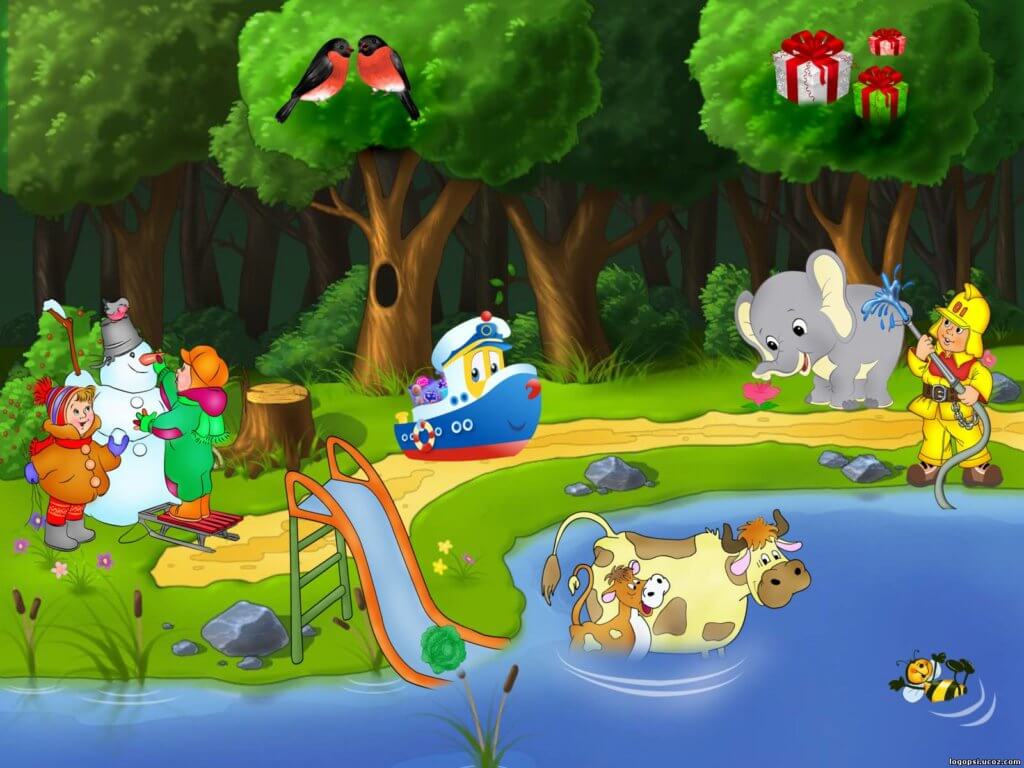
Trace the outline
As material, figures are given, only half of which are shown in outline in the figure. The goal is to accurately replicate the left half of the image on the right side. Based on the results of the work, the speed of its completion, accuracy (the outlines of the figures are depicted in the same places as on the left side, the corners are accurately connected) and accuracy (the lines are drawn straight) are assessed. The highest score is given to children who spent less than 90 seconds on the work and completed their half of the image, accurately repeating the sample. The lowest score is awarded to preschoolers who complete the task in more than 150 seconds if the lines are not straight and the angles are connected incorrectly.
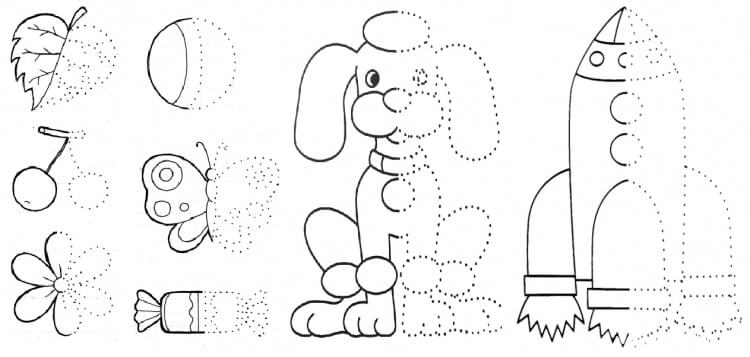
Finding the missing parts of the picture among those offered to choose from
In tasks of this type, the preschooler must find the missing fragment. Considering that most of the image is given, the child should have a complete image, based on which he can find the missing fragment like a puzzle. There are similar tasks where only part of the image is given and you need to understand what kind of whole image is hidden behind it.
Drawings on the topic of traffic rules in kindergartens - safety through the eyes of children
Tasks to find objects united by some common feature (generalization and classification)
In this type of task, it is proposed to combine objects according to image and likeness or functionality into groups or sort them according to the same criteria. For example, you are given a set of items, among which you need to find something that can be useful at school or on a hike, something that a doctor or cook uses. Children are also asked to combine drawings into pairs according to their purpose (for example, fork + knife), color (tomato + strawberry), shape (ball + orange), relationship (saw + log), etc.
Tasks to find patterns
In such tasks, you are given a series with repeating objects, the pattern of alternation of which you need to catch (leaf, flower, leaf, skip, leaf) or a series where the object changes incrementally and you need to guess what it will look like on a certain segment of the path (circle - circle with arrows - hours), etc.
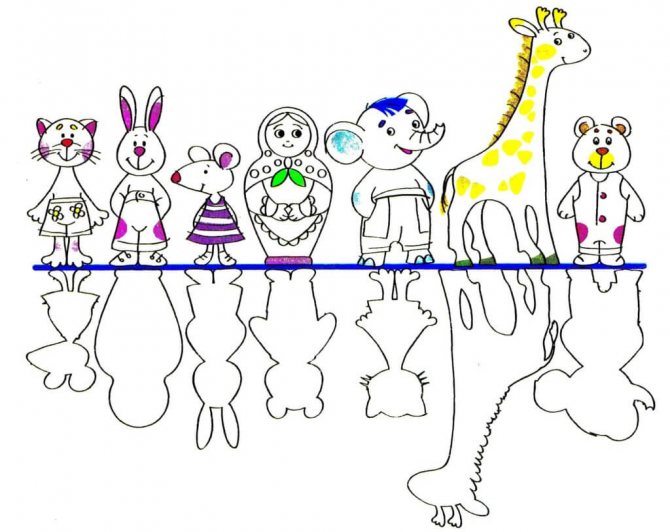
Fourth wheel
The tasks contain images of objects, among which you need to find one extra one. The remaining pictures need to be combined under one name. For three-year-old children, this could be a set: fox, hare, ball, wolf (an extra ball, the rest are animals). Further, the task becomes more complicated, for example, drawings are given: a fox, a hare, a giraffe, a wolf (an extra giraffe, since the rest of the animals live in the forest).
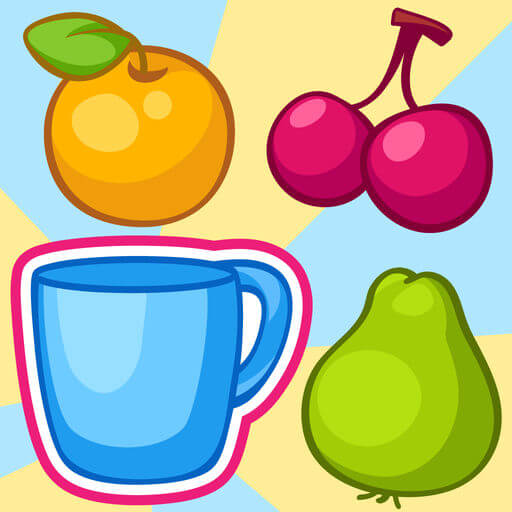
Diagnosis of creative thinking
It is a recognized fact: creativity is more a process than an end product. A creative approach to business means setting a problem for yourself and finding ways to best solve it.
That is why a person with creative abilities is distinguished by a strong need to learn new things. A high level of cognitive activity begins to manifest itself at an early age, when the child is just beginning to explore the world. It’s easy to see its manifestations by watching the baby:
- emotional reactions to new toys, objects, situations manifest themselves vividly and find a positive response to changes;
- great interest is shown in new people, ways of behavior, knowledge;
- high need for imitation, repetition of heard words and actions.
Questions from creatively inclined children can come as a surprise to parents and cause confusion, because... The inquisitive minds of children delve deeper into the question of interest. At age 5, inquisitive minds begin to conduct experiments, trying to find answers on their own. Also, at 5-6 years old, the growing level of need to understand the world around us pushes the child to try to answer his own questions. The search for solutions to problems is carried out systematically and consistently. Closer to primary school age, the child has a need to share his discoveries with his immediate environment.
To assess the creative abilities of children in psychology, a number of criteria identified by the American scientist P. Torrence are used:
- productivity;
- flexibility;
- originality;
- development of creative ideas and solutions.
To assess the creative abilities of preschool children, methods are used that give room for imagination; in the process of working on a task, the child can express himself and reveal his creative potential.
Methods for diagnosing the creative abilities of preschool children
Methodology for evaluating a fairy tale written by a child by O.M. Dyachenko and E.L. Porotskaya
During the study, children are asked to compose their own fairy tale, then its productivity, originality and variability are assessed. The lowest score is given to participants who refuse the proposed task or retell a well-known fairy tale. The highest score goes to children who managed to independently come up with a fairy tale and present it in detail.
P. Torrance test for creative thinking (adapted by N.B. Shumakova, E.I. Shcheblanova, N.P. Shcherbo)
The method contains two figures (a drop and a bean), a form with unfinished contours of images and a form with repeating lines, which are used to solve three problems (each takes 10 minutes):
- “Draw a picture” - test shapes are used to create a picture. The original forms can be supplemented with the necessary details, and then you need to come up with a name for the resulting picture.
- “Unfinished Shapes” - the child is asked to imagine what the original 10 unfinished shapes might look like. Each of them is tied to a stable image, but the more creative the created image, the more creative the preschooler’s thinking is. Each completed picture must be given a title.
- “Repeating figures” - the preschooler is given a form on which repeating paired lines are depicted. From each pair of lines you need to create a drawing. For this task, it is important to draw without repetition, coming up with different images.
Evaluation of completed work is carried out taking into account productivity, flexibility, originality and detail of completed tasks.
Creative task “Show how he moves and speaks”
This technique uses cards with images of animate and inanimate objects. For each of them, the child needs to come up with a speech, a manner of speaking, a language and a way of moving. After the presentation of the constructed images, an assessment occurs: a high level of creative thinking is characterized by the accuracy, integrity of the presented image and the expressiveness of its presentation; at a low level the image is not conveyed accurately and expressively.
Creative task “Three colors”
The preschooler is asked to choose three colors that match each other and fill the entire sheet with them. Next they ask what this drawing looks like, what it reminds the child of. If a preschooler has difficulties, it is allowed to add missing details to the drawing. After recognizing the images hidden in the drawing, the child is asked to come up with as many names for it as possible. The more the subject can see images and come up with interesting names for the image, the better his creative thinking is developed.
Thanks to this exercise, you can not only diagnose creative thinking, but also develop imagination and artistic perception.
Creativity, as a psychological process, is multifaceted, and therefore requires complex diagnostics to obtain reliable results.
From six to seven years. Features of age, age norms
The main pattern of mental development at this age is mental development. The development of voluntary attention and voluntary memory begins. There is a rapid development of all cognitive mental processes. Not only relationships with adults, but also with peers become important. Children are already striving to find solutions to the problems they face on their own.
The level of development of cognitive processes in children of this age can be assessed using various tests and techniques.
“Labyrinth” technique
The child is presented with a rather complex labyrinth, the entrance and exit of which are indicated by arrows.
The child must take a pointer with a thin, pointed end in his hand and, moving it along the picture, go through the entire labyrinth as quickly as possible, without touching the walls of the labyrinth.
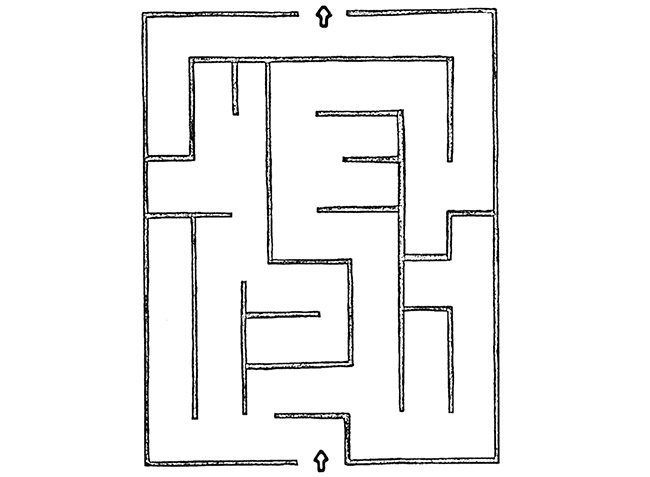
The test should be carried out with a stopwatch, clearly marking the end time of the task.
Evaluation of results
Very high level - the task was completed in less than 45 seconds, and the child never touched the walls of the maze with the pointer.
High level - the task is completed in a time not exceeding 1 minute; 1-2 touches of the maze walls with the pointer were noted.
Intermediate level - the task is completed in a time from 1 minute to 100 seconds, the child touched the walls of the maze 3-6 times.
Low level - the task was completed in 100 seconds to 2 minutes, the pointer touched the walls of the maze 7-9 times.
Very low level - the task was completed in more than 2 minutes, or not completed at all.


